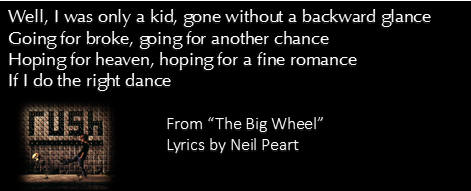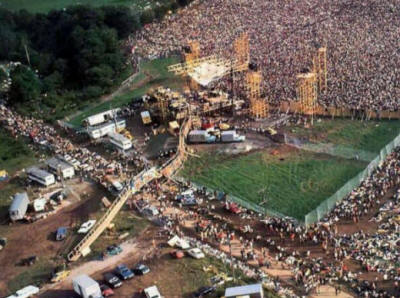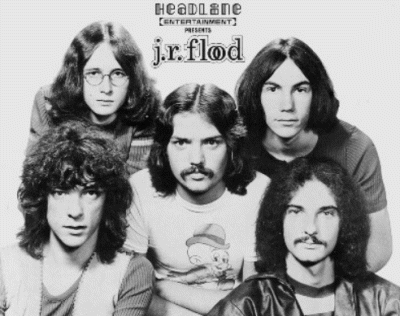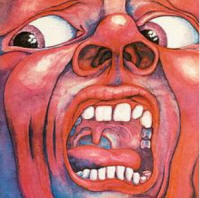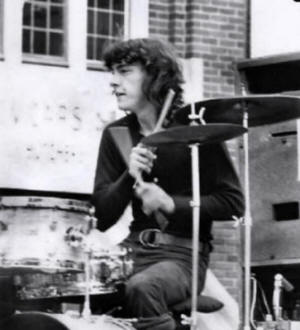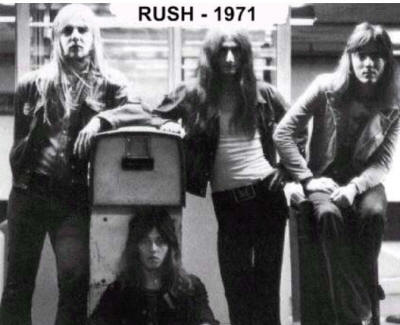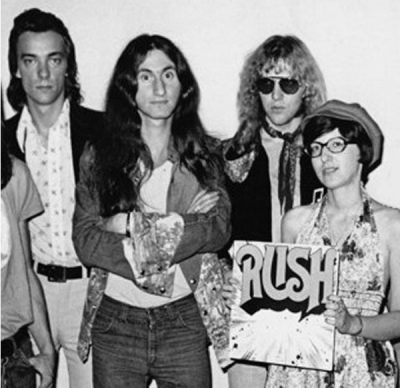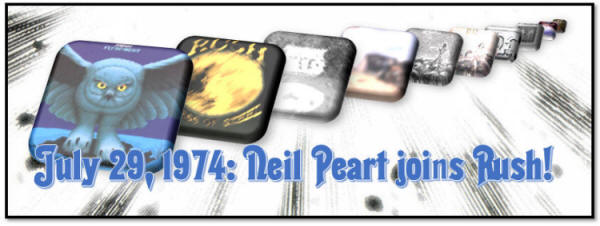III. Late teens - early adult years (1969-1974): Becoming a professional musician
Updated: 05/29/2017
![]() Indicates
important musical events related to Neil Peart or Rush.
Indicates
important musical events related to Neil Peart or Rush.
1969
January: The Beatles perform live for the last time on the rooftop of Apple Records.
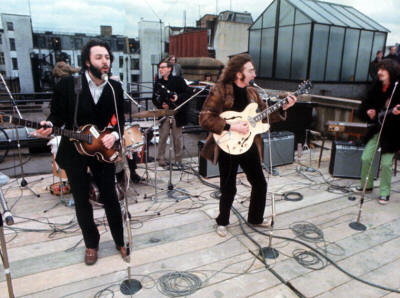
January: Led Zeppelin release their eponymous debut album. It reaches the Top 10 in the UK and US. Led Zeppelin's influence was felt everywhere in music, and especially on Rush's debut album.
March: Genesis release their first studio album, From Genesis to Revelation. In future interviews, Peart named Phil Collins as one of his early drum influences. Geddy Lee has also stated the importance of the Genesis album Nursery Cryme in developing Rush's sound and approach:
"That was when I first discovered the notion of a 'concept' and that it could be an adventurous and lively place and not dull at all. It is a very playful and compelling record. I fell in love with the sound of it. I was totally entranced by it and wanted to know how they had done it. This is part of the roots of Rush. The creation of a flexible concept. The parallels are obvious." [From an interview with The Quietus, "In The Mood: The Favourite Albums Of Rush's Geddy Lee
-
May: Ray Daniels becomes Rush's manager. Daniels would continue to manage Rush for over four decades.

May 19: Peart sees The Who for the second time at the Rockpile. [Traveling Music, p.79]
August: Woodstock is held in New York from August 15-18. Peart and a few bandmates had planned to attend, but when trying to buy tickets in Buffalo, NY, they're told the festival had been canceled. [Traveling Music, p.150]
-
The Majority break up. A few members, including Peart, Joe Szilagy, and Wayne King, form a short-lived band called “Damian.” [As told by Joe Szilagy, 2014]
-
Rush goes through multiple personnel changes [exact dates unknown]:
Lindy Young (brother of Geddy Lee's future wife Nancy Young) joins Rush to play keyboards.
Rush splinters into two bands: Hadrian with Alex Živojinović (Alex Lifeson), Joe Perna, John Rutsey, Lindy Young, and Bob Vopni and Oglivie/Judd with Gary Lee Weinrib (Geddy Lee), Sammy Rohr, Xavier "Sam" Dangler, and Lindy Young. Both are managed by Ray Daniels. [Rush: The Illustrated History, p. 12 and Rush Rediscovered liner notes]
Above photo: L-R: Joe Perna, Alex Živojinović (Alex Lifeson), John Rutsey and Lindy Young [From Rushisaband post, 2009]
-
The members of Hadrian and Oglivie/Judd combine to form Wild Woodpecker Revue for one show, and include Alex Živojinović (Alex Lifeson), John Rutsey, Gary Lee Weinrib (Geddy Lee), Sammy Rohr, Ian Grandy, and Steve "Stove" Moffat. [Rush Rediscovered liner notes]
-
Peart joins his fifth band, J.R. Flood.
After a couple of years playing in various versions of the Majority, the band self-destructed for the last time, and I evolved a new strategy. I thought the best musicians in the area were in a band called J.R. Flood, but I didn’t think the drummer was as good as the rest of them (I didn’t think I was either, but that didn’t affect what I wanted). [Traveling Music, p.84]
Above: Neil Peart and J.R. Flood
- Peart takes his first motorcycle ride. Later, his motorcycle would provide an escape from the alienation of touring life, as well as means of survival after the devastating personal losses of his daughter (1997) and wife (1998). He chronicled his healing journey in the 2002 book Ghost Rider.
Another life-altering experience occurred when I was about seventeen, and my Dad gave me an old minibike that had been kicking around his shop for a few years. I had my first adventures on a motorized two-wheeler, but alas, it ended badly. Riding along the sidewalk (wearing no helmet, gloves, or anything protective) down to Lakeside Park and along the deserted midway... I rode that little orange minibike to where the asphalt ended at the pier. I saw that a few cars were parked there, as I went to turn around and go back, but I hit a patch of drifted sand and slid sideways, my wheels rolling right across the side of a Volkswagen Beetle and dumping me on the beach (sand rather than pavement, luckily). [Traveling Music, pp. 80-81]
Neil Peart in Quebec City, 2013 - Photo by Michael Mosbach. Originally published in NeilPeart.net - News, Weather and Sports: July, 2013 - "On Days Like These."
- Peart quits high school to try being a full-time musician: "... at seventeen, I was old enough to consider leaving school. J.R. Flood was working most every weekend, and the other members had quit school to be full-time musicians, so I began lobbying my parents to let me try being a full-time musician, 'just for a year.' If it didn’t work out, I promised I would go back to school. [Traveling Music, p.85]
Above: Photo of Neil Peart, circa 1969
-
LP albums overtake "45" single sales for the first time.
-
September: The original Rush trio of Geddy Lee, Alex Lifeson, and John Rutsey reforms.
-
Yes release their debut album, Yes. The band was one of the pioneers of progressive rock and a major influence on Rush. Yes also included two of Peart's drum influences, first Bill Bruford and later Alan White.
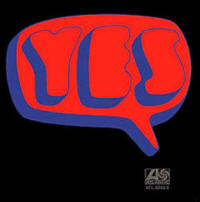
Geddy Lee was also influenced heavily by Yes and bassist Chris Squire:
"Of course I loved Chris Squire's incredible bass…and am still a huge fan. Quite amazing. But Yes provided an incredible array of intricate arrangements and a musicality beyond belief. They are often knocked for being too complex but I don't agree. There is a simplicity and elegance to the songs. I always found them both accessible and adventurous." [From an interview with The Quietus, "In The Mood: The Favourite Albums Of Rush's Geddy Lee"]
In 2017, Geddy Lee and Alex Lifeson would induct Yes into the Rock and Roll Hall of Fame. Lee said in his induction speech, "...through Yes, I was tuning into a wider world of possibilities. One where music seemed to have no limitations." Lee also took to the stage to perform "Roundabout" with his heroes, filling in for the late Chris Squires.
- October: King Crimson release In the Court of the Crimson King. In addition to being a seminal progressive rock album, drummer Michael Giles (and later Bill Bruford) would be a major influence of Peart's.
1970
- Peart has first recording session in the studio (Toronto Sound Studios), where he would later record Fly By Night, Caress of Steel, and 2112 with Rush. [Traveling Music, p.86] Listen to a recording of the demo.
Above: Photo of Neil Peart playing in J.R. Flood originally published in NeilPeart.net, News, Weather and Sports - May, 2010 - "Time Machines." Photographer unknown.
1971
-
Jan 1: The drinking age in Canada is lowered from 21 to 18. This increases the demand for live music beyond the weekends, providing Rush and other bands more nights to play. It's during this time that the members of Rush realize they can make a living at playing music. [Rush: The Illustrated History, p. 13]
-
June: Peart moves to London, England, to chase his dream of becoming a professional musician. He arrives without his drums, which would take another month or so to arrive by ship. Upon his arrival, he visits all the record companies and management agencies of his favorite bands to offer his services as a drummer, but has no luck.
...weeks were passing, and at the end of a month in London, I was running out of money. I had arrived with $200 to live on ... and it was getting low. I had become well acquainted with the London Transport system as I rambled through my list of record companies and management agencies, but I hadn’t found any opportunities, or any promising “drummer wanted” ads in the music papers. I decided not to waste my dwindling resources, but just try to wait until my drums arrived, and something would come up. [Traveling Music, p. 205]
- July: After years of focusing all his energy on drums and music, Peart returns to his love of reading to pass the time as he's waiting for his drums. One book, Samuel R. Delany's Fall of the Towers, would provide an influence on Peart's early lyric writing.

Photo of Neil Peart in England in 1971. Originally published in Peart's 1996 instructional video, A Work in Progress.
- Late July: Nearing the end of his savings, Peart has a chance encounter with another acquaintance from St. Catharines in Piccadilly Circus that leads to a job offer at a store called "Gear" on Carnaby Street. He finds that his days spent working at his father's farm equipment store have prepared him well for organizing merchandise. [Traveling Music, p. 209]
- August/September - Peart joins band English Rose. [Traveling Music, p. 211]
- [Exact date unknown] Mitch Bossi joins Rush on rhythm guitar for a short stint.
Above: Photo of Rush with Mitch Bossi (seated). [From Rushisaband post, 2009]
- Peart rediscovers the big-band music of his father. Peart would return to his big-band roots in the 1990s.
... In the early 70s, when I lived in a London bed-sitter with my childhood friend Brad, I rediscovered my father’s music, the big band stuff like Duke Ellington, Count Basie, and Frank (Sinatra), and I bought my own LP versions of them. [Traveling Music, p. 25]
-
October: November: Peart quits his day job at Gear to work full time in English Rose. Once again, the opportunity leads nowhere. [Traveling Music, p. 213]
-
November: Peart fills in for one night with the band Heaven, "a moderately-successful white R&B band, with six or seven members and a decent singer." The gig at Salford University turns out to be a disaster, as Peart contends with a hostile keyboard player and no rehearsal time to learn Heaven's original songs. At the end of the night, the band only pays him half of his promised salary of 20 pounds. [Traveling Music, p. 213-214]
-
December: Peart returns home to St. Catharines for the holidays. "I went back to St. Catharines all 'anglicized' (after a whole six months), with my new corduroy suit from Lord John on Carnaby Street, patterned sweater-vest, and affected accent." [Traveling Music, p. 215]
1972
- January: Peart returns to London and goes back to work at Gear on Carnaby Street.
I was much wiser about the harsh realities of the London music scene, and the harsh realities of life, and I had tasted poverty. I could see that making a living in music was going to be tough, but, I had also learned that working at a “normal” job could offer certain rewards of security, self-sufficiency, and even satisfaction. [Traveling Music, p. 215]
- [Exact date unknown] Peart's parents visit him in London.
-
Peart becomes a manager of Gear on Carnaby Street and continues to pursue music part-time. Again, nothing works out. [Traveling Music, pp. 215, 218-219]
-
Peart attends many concerts in London, including: Sha-Na-Na, Al Kooper, Grand Funk Railroad, Humble Pie, Pink Floyd, The Who, Tony Bennett, and many local acts. [Traveling Music, p. 219]
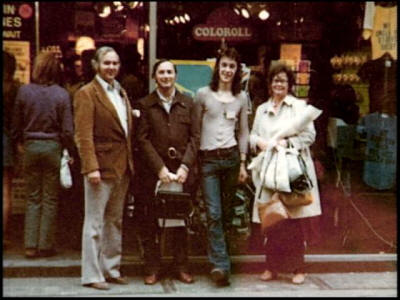
Above: Photo of Neil Peart with his parents in England, 1972. Originally published in Peart's 1996 instructional video, A Work in Progress.
-
December: Peart moves back to St. Catharines.
... By the end of 1972, I was becoming disillusioned. Having grown up a lot in those eighteen months, supporting myself, working for a living, knocking around the small-time London music world without success (or notice!), I had learned a little more about how the world worked. Even if I “got good,” it didn’t mean I was going to be successful, and the choice seemed to lie between playing good music and starving, or making a poor living playing bad music. Once again, life seemed to be standing still, and I was feeling that itch again. Now what? A “dear John” letter from my girlfriend back home helped make up my mind, and by Christmas I was back in St. Catharines with my drums and records. [Traveling Music, p. 223]
-
Late December: Peart works at Sam the Record Man during the holidays in St. Catharines, where he meets his first wife, Jackie Taylor. [Traveling Music, p. 223]
-
December: Rush manager Ray Daniels and Vic Wilson form the management company SRO Productions. At this point, Rush personnel include the three band members, two managers, and original roadies Ian Grandy and Liam Burt. [Rush: The Illustrated History, p. 15]
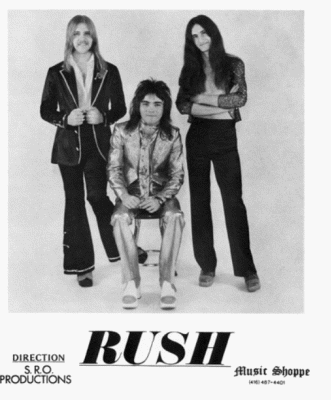
Above: Rush publicity photo
1973
- January: Peart goes to work full-time for his father Glen at Dalziel Equipment. [Traveling Music, p. 223]


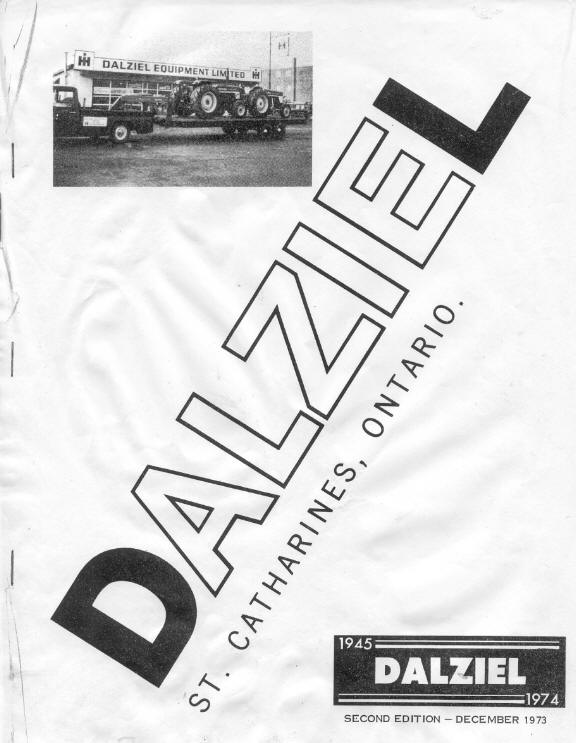
-
[Exact date unknown] Rush begin recording songs to for an upcoming LP album at Eastern Sound Studios in Toronto, produced by David Stock. The sessions are held late at night after gigs to save money.
-
Summer: Peart is promoted to parts manager at Dalziel Equipment. During this time, he forms his own band, Hush, and starts playing the bars.
I was disillusioned about the music business, but not about music, and I missed playing in a band. My former bandmates from J.R. Flood, guitarist Paul and organist Bob, had a new band called Bullrush, and they were still the local favorites, but they already had the best drummer around, Glen Gratto. (That summer I saw posters around the area for a concert featuring Bullrush and, by some agent’s inspiration, two similarly-named bands, Mahogany Rush and ... Rush. But I didn’t see that show.) [Traveling Music, pp. 223-224]
- Rush release their debut single "Not Fade Away," a cover the 1957 song by Buddy Holly and The Crickets. The B-side is an original song, "Can't Fight It." The single reaches #88 on Canada's charts.
-
Fall: Drummer Gerry Fielding briefly replaces John Rutsey in Rush. By this point, Alex Lifeson and Geddy Lee have adopted stage names.
-
November: Unhappy with the results from recording at Eastern Sound Studios, Rush moves to Toronto Sound to re-record some songs and remix others. Alex Lifeson later reflected on this decision:
We did part of the album at Eastern Sound in Toronto in early-1973, but figured we could do better. So in November we went to Toronto Sound to re-record some of it and totally remix it. The first stab at the album was done in eight hours following a gig. We were warmed up after the show, and it came very easy. Then it was recut in November in about three days, including mixing time. We were lucky in that most of the songs came in two or three takes. [From Ultimate Classic Rock: 40 Years Ago: Rush Release 'Rush']
Terry Brown is called in to "repair" the album and make it sound closer to what the band had envisioned. Brown would go on to produce Rush's next nine albums.
1974
-
March: After being rejected by every label, Rush release their eponymous album on their own label, Moon Records.
-
After March: Cleveland WMMS-FM music director Donna Halper gets Rush's "Working Man" played on Denny Sanders show. The phones light up (although most of the listeners mistake Rush for Led Zeppelin!). After a few days of playing "Working Man," "Finding My Way," "Here Again," and "In the Mood," record stores start calling. After the Rush album sells out from the import store Record Revolution, Halper helps to promote a Rush concert in Cleveland. [In the beginning... The Story of the Discovery of Rush by Donna Halper, circa 1988.]
Above: Photo of Neil Peart, Geddy Lee, Alex Lifeson, and Donna Halper.
-
July: Donna Halper puts in a good word for Rush with Cliff Burnstein at Mercury Records, helping to land Rush a $200,000 American record deal with the label, including a $75,000 advance. Mercury reissues Rush in the United States in July 1974. [From Contents Under Pressure: 30 Years of Rush at Home & On the Road, p. 16]
Above: The Mercury edition of Rush's debut album
-
July: Rush parts ways with John Rutsey for health and artistic reasons. Suddenly in need of a drummer for an upcoming American tour, Rush's co-manager Vic Wilson visits Neil Peart at his day job:
One hot July morning in the summer of 1974, a white Corvette pulled up in front of Dalziel Equipment. Another drummer from the area, John Trojan, climbed out of the passenger seat, and introduced me to the driver, Vic Wilson, one of the managers of a band from Toronto called Rush. All I knew about them was seeing those Bullrush, Mahogany Rush, Rush posters from the previous summer, but apparently they had been playing bluesy hard rock around the Toronto-area bars for a few years, and had recently released an independent Canadian album financed by the management company. The manager said the album had been picked up by an American record company, Mercury, and an American tour was being planned for later that summer. It sounded very exciting (though by that time I had learned to be skeptical of a manager’s promises). [Traveling Music, pp. 224-225]
In Rolling Stone in 2008, Alex Lifeson and Geddy Lee reminisced about Peart's audition:
"The car pulls up, and there's all kinds of drums tied down to it, and this real tall, skinny guy comes out with really short hair," Lifeson recalls of Peart's entrance. "And we were so cool in satin pants and platform shoes and long hair and all that stuff, so I was thinking, 'Oh, this isn't going to work out at all.'
"Suddenly, he's playing all these triplets with his feet," says Lee. "And I looked at Alex, and Alex looked at me, and we're like, 'Uhhh.' You know in 30 seconds this is not a normal drummer here."
Peart's starting salary with Rush is $125 per week. [Traveling Music, p. 224]
Above: Photo from Beetle Magazine, December 1974
-
August 14, 1974: After two weeks of rehearsals, Rush plays their first show with Neil Peart in Pittsburgh at the Civic Arena, opening for Uriah Heep and Manfred Mann. [Traveling Music, p. 225]
< Back | Home >
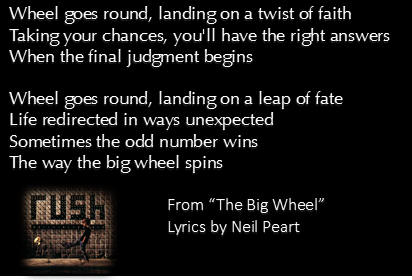
Updates
- September 28, 2014
- Added details of Peart's one-night gig with Heaven in November 1971.
- September 26, 2014:
- Added photo of Beatles rooftop concert
- Added photo of Rush manager Ray Daniels
- Added more details about Peart's first motorcycle adventure
- Added photo of Glen Peart
- Added photo of Dalziel equipment brochure
- September 23, 2014: Added new blockquote styles for Neil Peart, Alex Lifeson, and Geddy Lee.
- September 14, 2014: Added more Rush personnel changes and events to the timeline.
